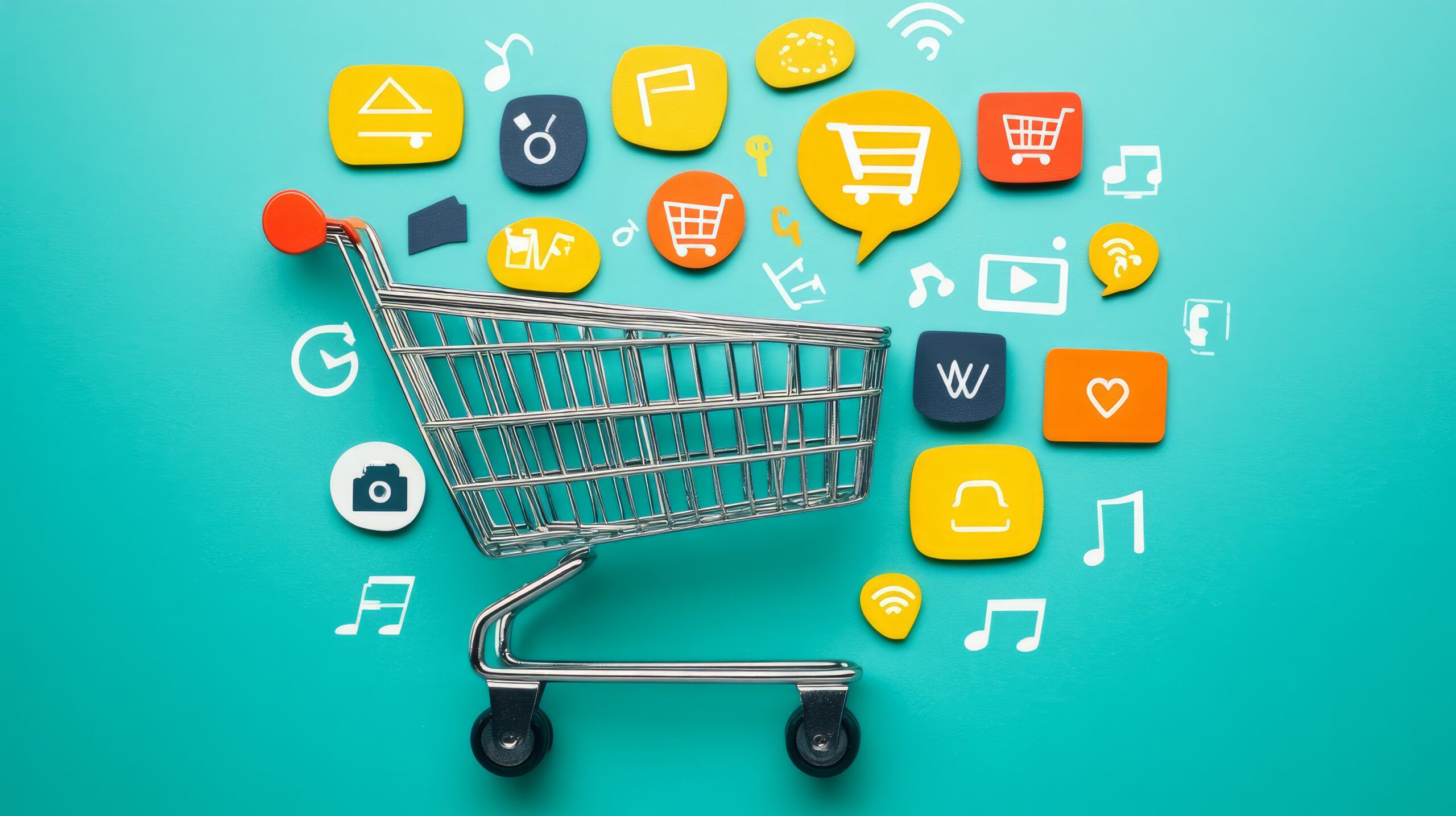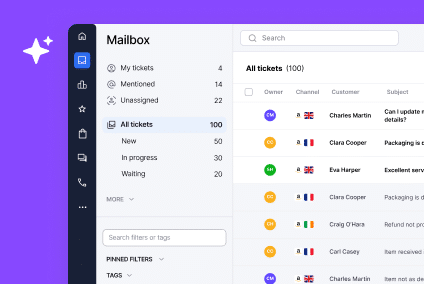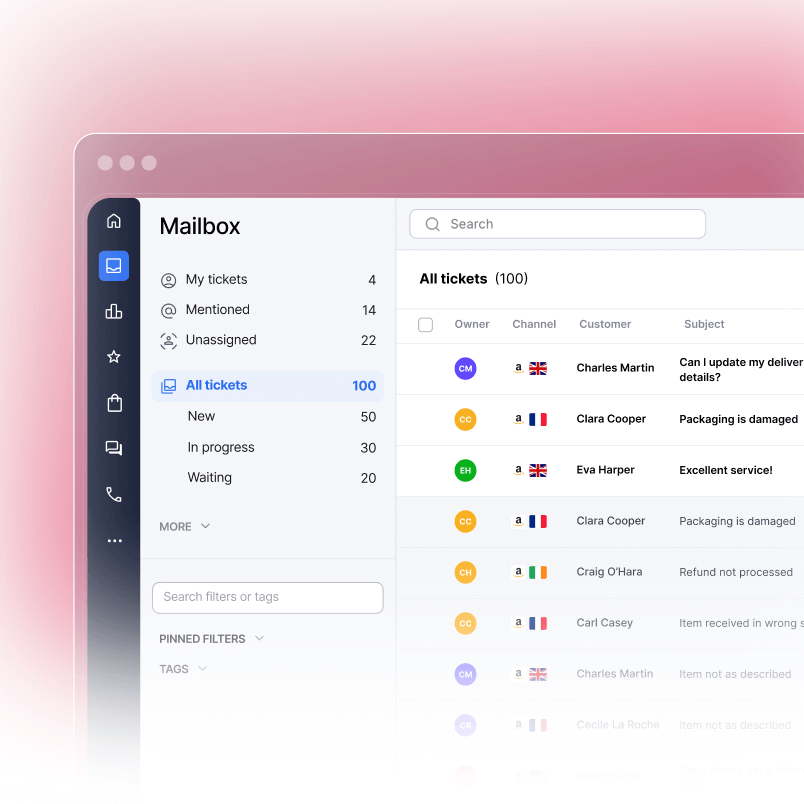When you’re selling on Amazon, eBay, Shopify, and TikTok Shop at the same time, customer support becomes a nightmare. Messages flood in from different platforms. You miss inquiries in your email. A customer complaint on Amazon sits unanswered while you’re handling a question on eBay. Your team spends half the day switching between tabs instead of solving problems.
This guide shows you how multichannel ecommerce software brings all those scattered conversations into one place. Multichannel ecommerce sales in the US have increased yearly since 2020, and omnichannel customers spend 13% more per transaction. You’ll learn what features matter, which platforms work best for your business, and exactly how to set up a support system that scales across 250+ channels without burning out your team.
The Real Problem with Selling Across Multiple Channels
You’re not just managing a store. You’re managing several stores at once.
Each marketplace sends messages differently. Amazon has its messaging system. eBay has Resolution Center. Shopify uses email and built-in contacts. Instagram and TikTok have DMs. Etsy has its own platform. And your website probably gets emails too.
Without a unified system, your support team faces three major obstacles. First, they waste time context-switching. An agent starts answering an Amazon message, gets distracted by an eBay notification, and loses track of what they were doing. Research shows it takes an average of 23 minutes to refocus after an interruption, during which your agents are less effective.
Second, tickets fall through the cracks. One team member checks Amazon. Another monitors email. A third person watches Etsy. When someone takes time off or forgets to log in, messages sit unanswered. Your response time climbs. 52% of customers stop purchasing from companies due to slow response times, and 40% of consumers expect responses within an hour on social media while only 50% of businesses meet these standards.
Third, your team can’t see the full picture. A customer messages you on Amazon today and eBay tomorrow. Your support agent on eBay has no idea the same person already contacted you. They repeat the same conversation. The customer feels ignored. Trust erodes.
The result. High response times. Low customer satisfaction scores. Negative reviews. Missed sales from repeat customers. This happens not because your team doesn’t care, but because the tools force them into chaos. 80% of customers value their experience as much as products or services, and omnichannel customers have 30% higher lifetime value than single-channel customers.
Why Manual Multichannel Support Fails
Spreadsheets don’t work. Shared documents don’t work. Even email forwarding systems break down once you hit 3 to 5 channels. Consumer outreach through social media increased by 27% in 2023 compared to 2022, making manual tracking obsolete at scale.
Manual tracking creates blind spots. When an agent resolves a ticket on Amazon, does the eBay team know? Does anyone update your CRM? Probably not. Inconsistent data means inconsistent service.
Speed suffers. Going back and forth between apps to look up an order, check a return policy, and craft a response takes your agents out of flow. A question that should take 2 minutes takes 10. Multiply that by 200 daily messages, and you’ve lost 26 hours of productivity.
Reporting becomes impossible. You can’t see which channels get the most inquiries. You can’t track your average response time by platform. You have no data to improve. You’re flying blind.
What Is Multichannel Ecommerce Software
Multichannel ecommerce software is a centralized inbox that connects to all your sales channels. Instead of juggling Amazon, eBay, Shopify, and 200 other platforms separately, you see every customer message in one place.
The software does three core things. It pulls in messages from every channel you use. It syncs order data so your agents see purchase history, shipping status, and return information without leaving the app. It organizes conversations so your team handles tickets efficiently and consistently.
Many people confuse multichannel and omnichannel. Here’s the difference. Multichannel means your customer interactions happen across many platforms. Omnichannel means those interactions feel seamless to the customer. You see all messages (multichannel). The customer sees one consistent experience (omnichannel). Good multichannel software helps you build omnichannel support.
Core Features Your Support Platform Needs
When evaluating multichannel support software, look for these essentials.
Unified Inbox
Everything arrives in one place. Emails, marketplace messages, social DMs, and website contacts. Your team doesn’t switch apps. They work from one dashboard. Time saved compounds quickly.
Native Integrations with Major Platforms
The platform should connect directly to Amazon, eBay, Walmart, Etsy, Shopify, and BigCommerce. Native integrations are faster and more reliable than workarounds. They also automatically sync order information.
Real-Time Order Lookup
An agent should pull up order details instantly. Order number. Tracking code. Return status. Payment method. Without clicking away from the support app. This speeds up responses dramatically and reduces the need for customers to repeat their order number.
Smart Routing and Prioritization
Messages should automatically route to the right agent. Complex issues go to senior staff. Repeat customers go to someone who helped them before. Urgent issues jump the queue. This prevents bottlenecks and improves response times.
SLA Tracking Per Platform
Service Level Agreements vary by marketplace. Amazon expects faster responses than your own website. Your software should enforce SLAs and alert your team before deadlines pass.
Macros and Auto-Responders
Your agents should have quick templates for common questions. Can I track my order? How do I return an item? What’s your shipping time? Macros cut response time from 5 minutes to 30 seconds.
Channel Performance Reporting
You need to see which channels create the most support volume. Which platforms have the longest response times. Where are your customer satisfaction scores lowest. Data-driven insights drive improvement.
How Multichannel Support Works: From Message to Resolution
Here’s what happens when a customer sends you a message after you implement multichannel software.
Customer sends a message on Amazon, eBay, Instagram, or any connected channel. The platform captures it instantly. Your team sees the message appear in the unified inbox alongside their other open conversations. Smart routing assigns it based on availability, agent skills, or customer history. The assigned agent opens the ticket and immediately sees the customer’s profile. Purchase history. Previous tickets. Order information. Current shipping status. Everything pre-loaded.
If the question matches a common issue, the agent uses a macro to respond in seconds. For complex questions, they have all the context they need. They can draft a personalized response that actually addresses the customer’s situation. They send the reply, and the system automatically posts it on the original channel. Amazon customers see responses in Amazon. eBay customers see them in eBay. Consistency across channels with zero manual republishing.
The ticket resolves. The platform logs it. Your reporting system updates automatically. You now have data on response time, resolution rate, and customer satisfaction. Over time, you spot trends. Most returns happen on Tuesdays. Friday messages take longest to answer. Shopify customers have different questions than Amazon customers. You optimize based on reality, not guessing.
Best Platforms for Multichannel Customer Support
Several platforms excel at multichannel ecommerce support. Here’s a breakdown of top options.
eDesk
eDesk connects to Amazon, eBay, Walmart, Etsy, BigCommerce, Shopify, and 50+ other channels. It syncs order data from each platform so agents see complete purchase history. The platform includes workflow automation, SLA tracking, and per-channel reporting. Many Amazon FBA sellers prefer eDesk because of its deep Amazon integration and features built specifically for marketplace sellers.
Gorgias
Gorgias focuses on ecommerce and integrates with Shopify, Amazon, eBay, Facebook, Instagram, WhatsApp, and email. It includes AI-powered automation that handles common questions without human intervention. The platform learns from your existing responses and suggests answers to new tickets. Gorgias excels for brands that want AI to handle volume first, then route complex issues to humans.
Richpanel
Richpanel connects to Shopify, Amazon, eBay, Facebook, Instagram, and email. It emphasizes customer self-service; customers resolve issues through a knowledge base before contacting support. For teams managing volume from social channels alongside marketplaces, Richpanel offers streamlined triage.
ChannelReply
ChannelReply specializes in marketplace sellers. It integrates with Amazon, eBay, Etsy, Walmart, and Shopify. The platform syncs inventory, orders, and returns data across all channels. ChannelReply focuses on preventing support tickets by automating common scenarios like shipping updates and return confirmations.
Zendesk
Zendesk is a general helpdesk platform. It doesn’t have native marketplace integrations but connects through third-party apps. For teams that already use Zendesk and want to add marketplace support, this works. For teams starting fresh, native solutions like eDesk or Gorgias integrate more cleanly.
Platform Comparison
| Platform | Key Channels | Standout Feature | Best For |
| eDesk | Amazon, eBay, Walmart, Etsy, Shopify, BigCommerce, 50+ | Deep marketplace integration | FBA sellers, marketplace-first businesses |
| Gorgias | Shopify, Amazon, eBay, social, email | AI-powered automation | Shopify stores with high volume |
| Richpanel | Shopify, Amazon, eBay, social, email | Knowledge base and self-service | Volume reduction through automation |
| ChannelReply | Amazon, eBay, Etsy, Walmart, Shopify | Inventory and return sync | Sellers preventing support tickets |
How to Set Up Multichannel Support in 5 Steps
Step 1: Audit Your Current Support Load
Count the channels you’re actively selling on. List the platforms where you receive customer messages. How many messages arrive each day on each platform? Which channels get the most inquiries? Which ones drain the most time from your team? Identify your biggest pain points. Is response time the issue? Missed messages? Repeated questions? This baseline tells you what success looks like later.
Step 2: Choose a Platform with Native Integrations
Pick software that connects directly to the channels you use. If you sell on Amazon, eBay, and Shopify, pick a tool that integrates all three natively. Avoid solutions that require manual forwarding or API workarounds. Native integrations are faster, more reliable, and handle data sync automatically.
Step 3: Connect All Your Marketplaces and DTC Store
Log in to your chosen platform and authorize each channel. Connect your Amazon Seller Central account. Link your eBay account. Add your Shopify store. Connect your email. This takes an afternoon at most. The software automatically pulls your order data and message history once connected.
Step 4: Set Up Workflows, Macros, and SLAs
Create response templates for your most common questions. Build routing rules so messages go to the right person. Set SLA targets based on each platform’s requirements. Configure auto-responders for after-hours. Test everything with a small batch of messages before rolling out to your full team.
Step 5: Monitor Performance and Iterate
Track your metrics. Average response time. First-response time. Resolution rate. Customer satisfaction matters most. If customers feel heard and helped, everything else improves. After two weeks, review what’s working. Adjust routing rules. Refine macros. Add new templates based on questions your team actually gets. Improvement is continuous. Businesses that incorporate AI into digital commerce achieve at least 25% improvement in customer satisfaction, revenue or cost reduction.
The Business Impact of Unified Customer Support
When you implement multichannel support software, four things improve immediately.
Response times drop. Your agents don’t waste time switching apps or finding order information. The average customer service response time is 12 hours and 10 minutes, but unified support systems can cut this dramatically. A question that used to take 10 minutes to answer now takes 3. Customers wait less. Expectations are met.
Fewer messages get missed. Everything arrives in one inbox. Nothing falls through the cracks. Consistency improves. Customers feel heard every time.
Customer satisfaction and reviews rise. Faster responses plus better context equals happier customers. Happy customers leave positive reviews. 88% of consumers are influenced by online customer service reviews when deciding what to buy. Positive reviews drive sales. This compounds over months.
Your team gets their sanity back. Support stops feeling chaotic. Agents work through organized queues instead of juggling tabs. Frequent interruptions increase stress and mental exhaustion among employees. They have the tools and information to do their job well. Job satisfaction increases. Turnover decreases. You keep experienced staff.
These benefits compound. Better reviews attract better customers. Better customers need less support. Your team handles more volume with the same headcount. Growth becomes possible without proportional cost increases.
Final Summary
Multichannel selling is now standard. Your customers expect consistency across platforms. Manual systems can’t deliver that. 89% of businesses are expected to compete primarily on customer experience, surpassing traditional factors like product and price. A good multichannel support platform brings order to chaos.
Pick a solution with native integrations. Connect all your channels. Set up workflows that reflect your business. Train your team. Monitor what works and adjust. Your response times improve. Your team gets focused. Your customers stay happy.
The cost of a platform like eDesk or Gorgias typically pays for itself in one month through productivity gains alone. The benefits multiply after that.
FAQs
What’s the best multichannel helpdesk for Amazon and eBay sellers?
eDesk leads for sellers focused primarily on Amazon and eBay because it integrates deeply with both platforms and was built specifically for marketplace sellers. Gorgias works well if you also sell through Shopify. Choose based on where your revenue actually comes from.
Can I see order details from Amazon inside my support tool?
Yes. Any platform with native Amazon integration pulls order data directly from Seller Central. You’ll see order number, items, price, tracking information, and return status. The data refreshes in real-time or near real-time depending on the platform.
How do I handle DMs from Instagram and TikTok in a multichannel support system?
Most multichannel platforms integrate with Instagram directly. TikTok Shop integration is newer but available on platforms like Gorgias and eDesk. You can also set up forwarding for TikTok DMs to email, then pull that email into your support platform.
Does multichannel software help with SLA enforcement?
Yes. Every platform listed here tracks response times and alerts your team before SLAs breach. Amazon requires responses within 24 hours. eBay has different standards. Your software enforces these automatically and escalates issues that are at risk of missing deadlines.
Will I need to retrain my entire support team to use this software?
Most multichannel platforms are intuitive. Your team can start using them productively within a few hours. Expect one day of training for new hires plus a week of adjustment as your team finds their rhythm. The learning curve is low compared to the productivity gains.
How much does multichannel support software cost?
Pricing varies by platform and volume. Expect to pay between $300 and $3000 per month depending on team size and channel count. Most platforms offer free trials so you can test before committing. The ROI typically appears within 30 days through response time improvements and reduced missed tickets.




